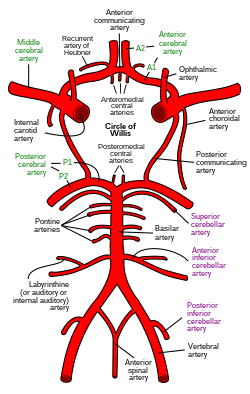| Circle of Willis | |
|---|---|
 Diagram of the arterial circulation at the base of the brain (inferior view), the circle of Willis is drawn in the upper half. Blood flows up to the brain through the vertebral arteries and through the internal carotid arteries. | |
 The arteries of the base of the brain. Basilar artery labeled below center. The temporal pole of the cerebrum and the cerebellar hemisphere have been removed on the right side. Inferior aspect (viewed from below). | |
| Details | |
| Identifiers | |
| Latin | circulus arteriosus cerebri circulus Willisii |
| MeSH | D002941 |
| TA98 | A12.2.07.080 |
| TA2 | 4516 |
| FMA | 50454 |
| Anatomical terminology | |
The circle of Willis (also called Willis' circle, loop of Willis, cerebral arterial circle, and Willis polygon) is a circulatory anastomosis that supplies blood to the brain and surrounding structures in reptiles, birds and mammals, including humans.[1] It is named after Thomas Willis (1621–1675), an English physician.[2]
- ^ Fenrich, Matija; Habjanovic, Karlo; Kajan, Josip; Heffer, Marija (2021). "The circle of Willis revisited: Forebrain dehydration sensing facilitated by the anterior communicating artery: How hemodynamic properties facilitate more good dehydration sensing in amniotes". BioEssays. 43 (2): 2000115. doi:10.1002/bies.202000115. ISSN 1521-1878. PMID 33191609.
- ^ Uston, Cagatay (9 March 2005). "NEUROwords Dr. Thomas Willis' Famous Eponym: The Circle of Willis". Journal of the History of the Neurosciences. 14 (1): 16–21. doi:10.1080/096470490512553. PMID 15804755. S2CID 146301989.